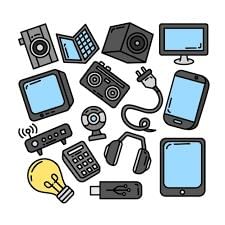Year 1 Exam > Year 1 Notes > Computing for Year 1 > How do we use digital devices?
How do we use digital devices? | Computing for Year 1 PDF Download
| Table of contents |

|
| What is a Digital Device? |

|
| How Digital Devices Work |

|
| Making a Remote Control Toy Bus Move |

|
| Writing a Story on a Computer |

|
What is a Digital Device?
A digital device is a tool designed to perform specific tasks, often containing a small computer inside. These devices require computer programs to function effectively.
Examples of Digital Devices
Here are some common digital devices:
- Smartphones
- Laptops
- Tablets
- Smartwatches

How Digital Devices Work
Digital devices operate based on instructions provided to them. Let's consider the example of listening to music on a mobile phone:
Listening to Music on a Mobile Phone
- When we want to play music on a mobile phone, we interact with a music app. To start the music, we typically tap a play button.
- After tapping the play button, the music begins playing through the phone's speakers or headphones.
Interacting with Digital Devices
Users interact with digital devices in various ways.
For instance:
- Touchscreens: Users can tap, swipe, or pinch to interact with devices.
- Voice Commands: Devices like smart speakers respond to voice instructions.
- Keyboards and Mice: Input devices for computers and laptops.
Question for How do we use digital devices?Try yourself: What are some common examples of digital devices?View Solution
Making a Remote Control Toy Bus Move
- We aim to set our remote control toy bus in motion by providing instructions for the wheels to start turning.
- Initiate movement by pressing the GO button on the remote control.
After Pressing the GO Button
- Upon pressing the GO button, the wheels of the bus will begin to rotate, propelling the bus along the floor.
Writing a Story on a Computer
- Our objective is to compose a story on a computer by specifying the words we wish to display on the screen.
- Create the narrative by typing the letter keys in the correct sequence on the keyboard.
Subsequent Action
- Once the letter keys are pressed on the keyboard, the screen will exhibit the words, shaping our story.
Key Definitions
Here are the explanations for some essential terms:
- Computer: A device capable of executing instructions stored in its memory.
- Digital Device: A machine containing a computer internally.
- Computer Program: A series of instructions understandable by a computer.
- Screen: The display area of a computer where images or text are visible.
- Speakers: Equipment used for playing sounds or music audibly.
- Headphones: Tools for private sound listening.
- Remote Control Handset: An electronic device controlling another device from a short range.
- Button: An object pressed to trigger an action.
- Keyboard: The part of a device with letter keys for typing.
The document How do we use digital devices? | Computing for Year 1 is a part of the Year 1 Course Computing for Year 1.
All you need of Year 1 at this link: Year 1
|
19 videos|25 docs|3 tests
|
FAQs on How do we use digital devices? - Computing for Year 1
| 1. How do digital devices help in education? |  |
Ans. Digital devices in education help in providing access to a wide range of resources such as online textbooks, interactive learning tools, and educational apps. They also facilitate distance learning, collaboration among students, and personalized learning experiences.
| 2. What are some common digital devices used in schools? |  |
Ans. Some common digital devices used in schools include laptops, tablets, interactive whiteboards, document cameras, and educational software.
| 3. How can digital devices enhance student engagement in the classroom? |  |
Ans. Digital devices can enhance student engagement by providing interactive and multimedia-rich content, enabling students to participate in online discussions and collaborations, and offering personalized learning experiences tailored to their needs and preferences.
| 4. What are some challenges associated with using digital devices in education? |  |
Ans. Some challenges associated with using digital devices in education include the need for adequate training for teachers and students, ensuring equitable access to technology for all students, addressing concerns about screen time and distractions, and safeguarding student data and privacy.
| 5. How can schools ensure the effective integration of digital devices into the curriculum? |  |
Ans. Schools can ensure the effective integration of digital devices into the curriculum by providing professional development opportunities for teachers, incorporating technology into lesson planning and delivery, promoting digital literacy skills among students, and regularly evaluating the impact of technology on teaching and learning outcomes.
Related Searches














